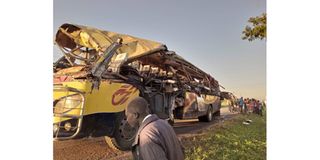Govt must urgently address the rampant road accidents

The wreckage of the bus that rammed into a stationary trailer along Kampala-Gulu highway, killing 16 people on January 6, 2023. PHOTO | COURTESY
Accidents are on the rise like never before and it is important for us to interrogate the major causes.
In just eight days, we had lost 83 lives and 297 seriously injured in 360 accidents. In just three days (December 23 and 26, we lost 55 lives in 206 road crashes; more than 50 lives between December 28 and January 1, 2023 in 104 road crashes.
On January 6, 16 people died in an accident on the Gulu highway. These figures are scary and yet keep escalating by day. Between December 2022 and January 2023, in just one week, we have lost over 80 people and 200 are injured.
In 2021, more than 37,000 died and more than 10,000 injured due to serious accidents and over 17,000 in minor accidents and the trend is worrying.
According to WHO, 1.3 million people around the world die due to accidents each year and leave between 20 and 50 million people with non-fatal injuries. More than half of all road traffic deaths and injuries involve vulnerable road users, such as pedestrians, cyclists and motorcyclists and their passengers.
Further, road traffic injuries are the leading cause of death for children and young adults aged 5–29. Young males under 25 years are more likely to be involved in road traffic crashes than females, with 73 percent of all road traffic deaths occurring among young males in that age. Developing economies record higher rates of road traffic injuries, with 93percent of fatalities coming from low- and middle-income countries such as Uganda.
Uganda has contributed highest to these statistics with 29 deaths per 100km according to the WHO Global status report on road safety. Road accidents do not only cause human suffering but also a heavy economic burden on victims and their families in terms of treatment costs for the injured, loss of productivity of those killed or disabled and this costs countries around 3 percent loss of their annual gross domestic product. This simply indicates that accidents do not only cause death and injuries but have significant impact on the socio-economic development of a country and therefore the need for the country to treat this urgently.
There are a number of causes of these fatal accidents both on the roads, railway and water and instead of acknowledging responsibility and work to do better, I have witnessed a lot of blame games which do not help.
This does not mean that I condone any indiscipline leading to accidents but that these accidents are all usually non-natural occurrences which we could have avoided in the first place. Police have attributed most accidents to dangerous driving and vehicles being in dangerous mechanical condition. If you have stayed in Uganda just for a day, you will quickly note how reckless most motorists and pedestrians are. You cannot expect drivers that defy traffic rules in the city to respect rules while on the highways. There seems to be always an urge to overtake and when you follow keenly, some are in a hurry to overtake to go pick children from school or join their favorite kafunda! We have also witnessed situations where many drivers assume the right of way even when they are not entitled to it and this too has harboured a bad culture.
The buses have become another death trap with their drivers driving recklessly to the extent that some were once banned, and indeed, there was some change. When it comes to Boda-bodas, the majority seem to either not understand traffic rules or simply choose to ignore; even with the introduction of junction boxes in some parts of the city, you will still see a swarm of Boda-bodas right in the middle of the junction box!
Most of our roads are dangerously narrow, dark and make it difficult for road users. Most of the road signs are missing and neither are most humps painted to clearly warn drivers. Some potholes have gained a perpetual status; for they will never be fixed! How many barriers do we have at railway crossings? How many roads are properly lit? How many road signs do we still have on the roads that one has to hit a hump in the night for them to know that it exists? How many ambulances do we have that can rescue accident victims? How many highways have emergency parking sideways; when a car breaks down in a corner on the Kisoro Road, where will the motorist safely park it? Do the Police have enough resources to deploy 24 hours on major highways?
Under the various legal regimes on road safety such as the Roads Act, UNRA Act, Traffic road and safety Act among others and under the UN Development Goals; SDG 3.6 and SDG 11.2, which seek to reduce road traffic deaths and injuries by 50 percent by 2020 and to provide access to safe, affordable, accessible and sustainable transport by 2030 respectively, it is the government’s sole responsibility to provide safe and adequate infrastructure to ensure that all roads are safe and motorable and that a victim can succeed in an action against the government for failure to ensure safety of road users.
As we caution drivers, the government through its MDAs has a bigger responsibility to ensure that all roads are safe and that all road users have proper information and infrastructure to guide them.
Michael Aboneka, [email protected]




